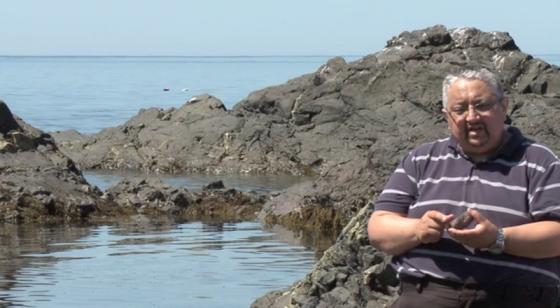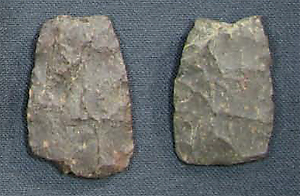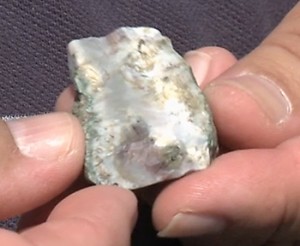
Arisaig

Tracadie Harbour projectile point bases made from maroon rhyolite found at Arisaig. From the collections of the Nova Scotia Museum, Archaeology Collections, Halifax, NS.

This image shows a vein of quartz and other fine-grained quartz-based material encased in basalt. Basalt is the primary material from which these toolstones are emerging (or “growing”) over a very long period to time.
Outcrops of volcanic rocks including basalts and rhyolites are found along the coast at Arisaig, in northern Nova Scotia. Archaeological evidence shows that our ancestors used a maroon rhyolite from this area to make tools, which shows up at ancestral sites all across Nova Scotia.
Along with this rhyolite, it is likely people also used the quartz and other silica-rich materials found at Arisaig. As the once molten basalt cooled, other minerals trapped in the basalt collected in veins and were fused into an almost glass-like structure (like the translucent fine-grained material shown here). Like maroon rhyolite, this silica-rich material can be flaked into sharp edges and fine points.
With the arrival of European ships some 600 years ago, a new mineral appeared on these beaches. European flint was stored in ships as ballast, and then dumped upon their arrival here. Also an excellent tool material, European flint was used by the Mi’kmaq to make arrowheads as recently as 200 years ago.


 sharing our stories
sharing our stories
I was digging in my yard (Aylesford NS) today and found a “large” (approx. 1lb, 1.5″x2″x2.5″) piece of red/amber flint. It shows clear signs of being worked (5 flaked faces), probably a piece of stock for tool making. If anybody is interested in photos or more or has info please contact.
Tyler.
Hi Tyler,
Wow! What an amazing find. I’m sure our team would love to see photos of it. You can email them to our Communications Officer at solange@cmmns.com. Can’t wait to see. Wela’lin!